India shares a long land border of over 1600 km with Myanmar as well as a maritime boundary in the Bay of Bengal. Four North-Eastern States viz. Arunachal Pradesh, Nagaland, Manipur and Mizoram share international boundary with Myanmar.
Both countries share a heritage of religious, linguistic and ethnic ties. India has “historical ties and traditional bonds of friendship and cooperation” with Myanmar Five Bs are the base of India-Myanmar relations – Buddhism, Business, Bollywood, Bharatnatyam and Burma teak.
As the land of Lord Buddha, India is a country of pilgrimage for the people of Myanmar. India and Myanmar relations have stood the test of time. The geographical proximity of the two countries has helped develop and sustain cordial relations and facilitated people-to-people contact.
Myanmar has a substantial population of Indian origin (est. 1.5 to 2 million). Further, Myanmar is gateway to South East Asia and ASEAN with which India is seeking greater economic integration through ‘Neighborhood First’ ‘Act East’ Policy. Myanmar also offers an alternative access route to the Northeast.
Apart from supply of pulses, possibilities of energy supply from offshore blocks in Myanmar and business opportunity that emerging from an opening economy underpin bilateral relations.
India and Myanmar signed a Treaty of Friendship in 1951. The visit of Prime Minister Rajiv Gandhi in 1987 laid the foundations for a stronger relationship between India and Myanmar. A number of agreements enhancing bilateral Cooperation have been signed between the two countries. Institutional mechanisms for facilitating regular dialogue on a range of issues of bilateral interest have also been established.
During 2002, the Indian Consulate General in Mandalay was re-opened and the Consulate General of Myanmar was set up in Kolkata. Following the cataclysmic cyclone ‘Nargis’ which hit Myanmar in May 2008, India responded immediately with relief materials and offers of assistance. India also provided assistance of US $1 million for humanitarian relief and rehabilitation in the areas affected by the severe earthquake in Shan State in March 2011.
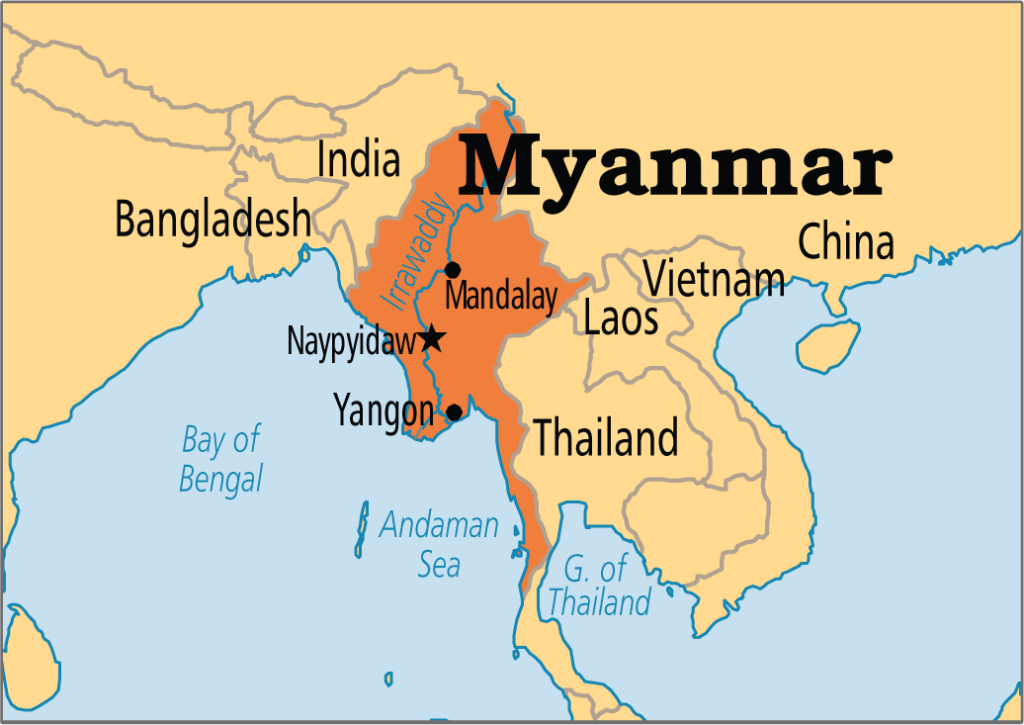
Areas of Cooperation
Political
- Building on civilizational relationship, since the 1990s, India adopted a policy of working on improved Government-to-Government relations. The landslide victory by Aung San Suu Kyi-led National League for Democracy (NLD) in November 2015 general elections and the formation of NLD government had provided opportunities to strengthen the engagement building on our previous efforts.
- Prime Minister of India Shri Narendra Modi visit to Myanmar (November 2014).
- The big focus of discussions was on improving connectivity between what the leaders called “brother countries.” The two leaders spoke about the need for more direct air links, as well as an India-Myanmar-Thailand trilateral highway, and the Kaladan multi-modal transport project .
- They also discussed other economic ties and cooperation in the oil and gas sector, as well as the need for more cultural contacts, including sending Myanmar’s students to Nalanda University.
- The two leaders reiterated the importance of building on the natural geographic, cultural and historic cultural links between the two countries.
- PM Modi had met the leaders on the sidelines of the East Asia Summit. While addressing the ASEAN leaders, he also unveiled India’s new Act East Policy.
- Myanmar State Councillor Aung San Suu Kyi visited India to participate in the BRICS-BIMSTEC Outreach Summit.
- During the visit, Myanmar reiterated its resolve not to allow its territory to be used against India, and Ms. Swaraj assured Ms. Suu Kyi of “all help” in “strengthening” Myanmar’s “democratic institutions and socio economic development”, and also extended support to Myanmar for a “better connected” future.
- Both sides signed three agreements following a meeting between Prime Minister Narendra Modi and Ms. Suu Kyi, to assist insurance, power and banking sectors.
- It is, however, noteworthy that she had visited China before coming to India. Thus , her visit was a reminder that India has a vast ground to cover if it hopes to match Chinese influence over Myanmar.
- In August 2016, Myanmar President visited India which was the first of a kind visit in over five decades. Also, this was his first foreign visit after him assuming office, showcasing the importance Myanmar holds for India. The then Indian President Pranab Mukherjee said that Myanmar was “a key partner in our ‘Neighbourhood First’ and ‘Act East’ policy.” Both countries also expressed their resolve to strengthen maritime security cooperation in the Bay of Bengal. Myanmar is the fulcrum that will determine the success of the ‘Act East Policy’.
- Major initiatives emphasised by Prime Minister of India Shri Narendra Modi which makes Myanmar to remain high in India’s regional diplomacy include:
- The ‘Act East’ policy
- The ‘Neighbourhood First’ policy
- The ‘Buddhist circuit’ initiative
- Greater emphasis on regional connectivity and
- Mandate to strengthen border security
- Myanmar has been in turmoil since February, 2021 when the military seized control of the country in a coup and detained Aung San Suu Kyi and other leaders of her National League for Democracy (NLD).
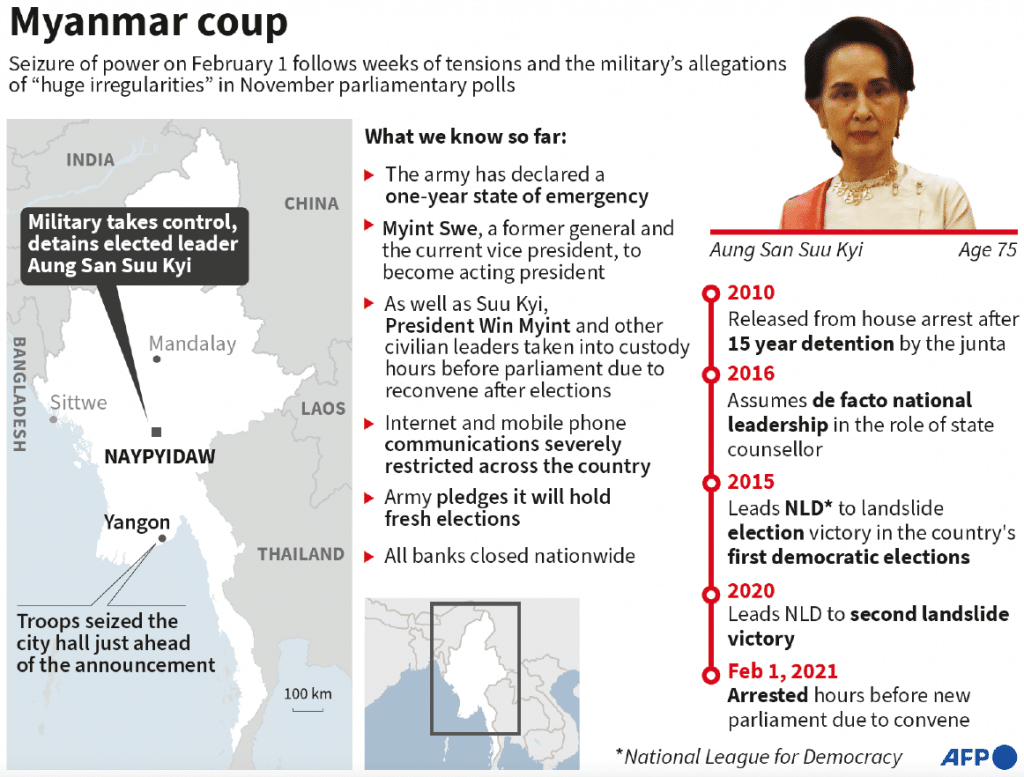
Act East Policy
- One of the major foreign policy pronouncements of Indian Prime Minister since coming to power has been the ramping up of ‘Look East’ to ‘Act East’ policy . He used the 12th India-ASEAN summit held in Myanmar in November 2014 to unveil the new policy.
Neighbourhood First Policy
- In November 2014 at the 18th SAARC Summit held in Kathmandu, Prime Minister of India proposed his vision for South Asia. He emphasised “inter-linked destinies” and “shared opportunities,” In neighbourhood first policy, Myanmar finds itself at an advantageous position.
- India has recognised that it has to take along its neighbours in its rise, as that is the most effective strategy to stabilise the neighbourhood, which is a critical factor for development that India has a vast ground to cover if it hopes to match Chinese influence over Myanmar.
Buddhist Circuit
- The ambitious ‘Buddhist Circuit’ initiative has been planned to connect all major Buddhist destinations across India. Myanmar’s Buddhist linkage with India goes back several centuries. India is a land which many Buddhists followers in Myanmar wish to visit for religious purposes. Buddhist influence from India laid the basis for building a strong cultural relationship between the two countries, but remained largely untapped until recently. More than 80 percent of the total population of Myanmar is Buddhist.
Economic
- Bilateral and multilateral economic ties and interdependencies help determine the prospects of a country’s domestic economic development as well as its potential for growth and prosperity. Understanding such benefits of economic cooperation, India and Myanmar set up in 2003 a Joint Trade Committee (JTC) to appraise their bilateral trade and development. The 6th JTC was co-chaired by Commerce Ministers of the two countries in the year 2017.
- In 2008, the two countries signed a Bilateral Investment Promotion Agreement (BIPA) and a Double Taxation Avoidance Agreement (DTAA).
- Both are also signatories to the India-ASEAN Trade in Goods Agreement; geographically, Myanmar is positioned as a bridge between India and the ASEAN member countries.
- Bilateral trade has expanded significantly from US$ 12.4 million in 1980-81 to US $ 1,338.29 million in 2010-11. India’s imports from Myanmar are dominated by agricultural items (beans, pulses and forest based products form 90% of our imports). India’s main exports to Myanmar are primary and semi-finished steel and pharmaceuticals.
Trade and Transit
- India and Myanmar signed a border trade agreement in 1994 and have two operational border trade points Moreh-Tamu and Zowkhatar-Rhi on the 1643 km long border. A third border trade point is proposed to be opened at Avakhung-Pansat/Somrai.
- During the 3rd India-Myanmar Joint Trade Committee in October 2008, it was agreed that Border Trade at the existing points would be upgraded to Normal Trade so as to promote bilateral trade between the two countries. Notifications to this effect have been issued by both sides.
- India and Myanmar signed an important MoU on 22 October 2018 for the appointment of a private Port Operator for the Operation and Maintenance of Sittwe Port and associated facilities included in the Kaladan Multi Model Transit Transport Project.
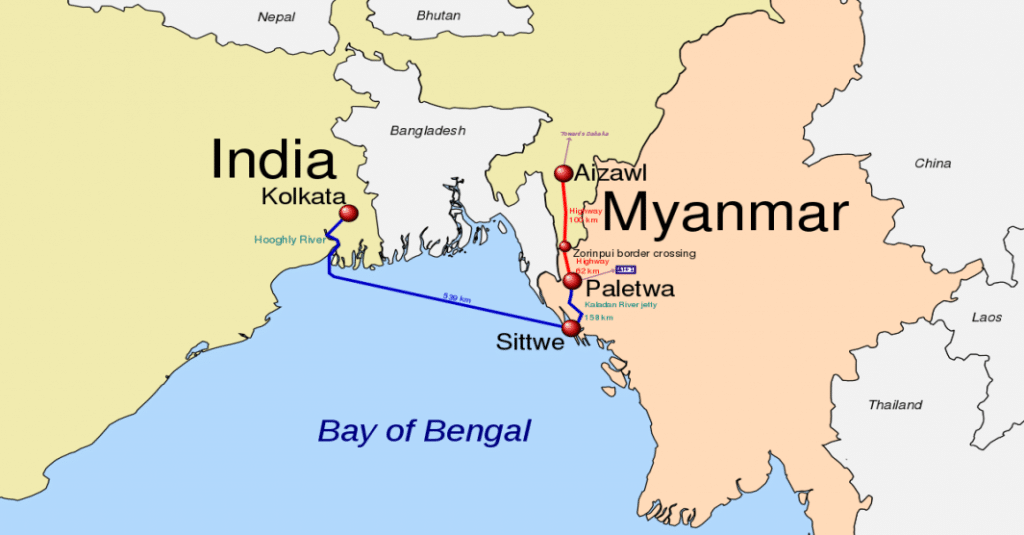
Physical Connectivity Project between India and Myanmar
| Project | Stretch | Remark |
|---|---|---|
| The Kaladan Multi-Modal Transit Transport Facility | The sea, river, land transport system linking Indian ports and Sittwe port in Myanmar and then through riverine transport and by road to Mizoram (India). Implementation commenced in Dec. 2010 | Ongoing |
| The India Myanmar Thailand Trilateral Highway Project | The 1360 km cross-border transportation network would link Moreh (India) to Mae Sot (Thailand) through Bagan (Myanmar) | Expected to be completed by 2023. |
| The Mekong India Economic Corridor | The corridor proposes to connect Ho Chi Minh (Vietnam) with Dawei (Myanmar) via Bangkok (Thailand) and Phnom Penh (Cambodia) and further linking it to Chennai (India) | Proposed |
| The Stilwell Road (the Ledo Road and the Burma Road) | The WW II overland road linking Ledo in Assam (India) to Kunming in Yunnan (China) through Myanmar | The section from Myitkyina to India Myanmar border needs upgradation. Reopening of the road remains an issue of debate in India and Myanmar |
| The Delhi-Hanoi Railway Link | The Delhi-Hanoi train connectivity proposes to link India with Vietnam via Myanmar, Thailand, Malaysia, and Singapore | Proposed |
| The Tamu-Kalewa-Kalemyo Friendship Road | The 160 km cross-border road from Tamu to Kalemyo in Myanmar’s Sagaing Region and forms par to the IndiaMyanmar Thailand Trilateral Highway | Completed in 2001 (India has taken additional task for upgradation) |
| The Rhi-Tiddim Road in Myanmar | The 80 km cross-border road from Rhi to Tiddim in Myanmar’s Chin State | Ongoing |
| The BCIM Economic Corridor | The cross-border transportation network linking China’s Kunming to India’s Kolkata from Myanmar and Bangladesh | Prospective |
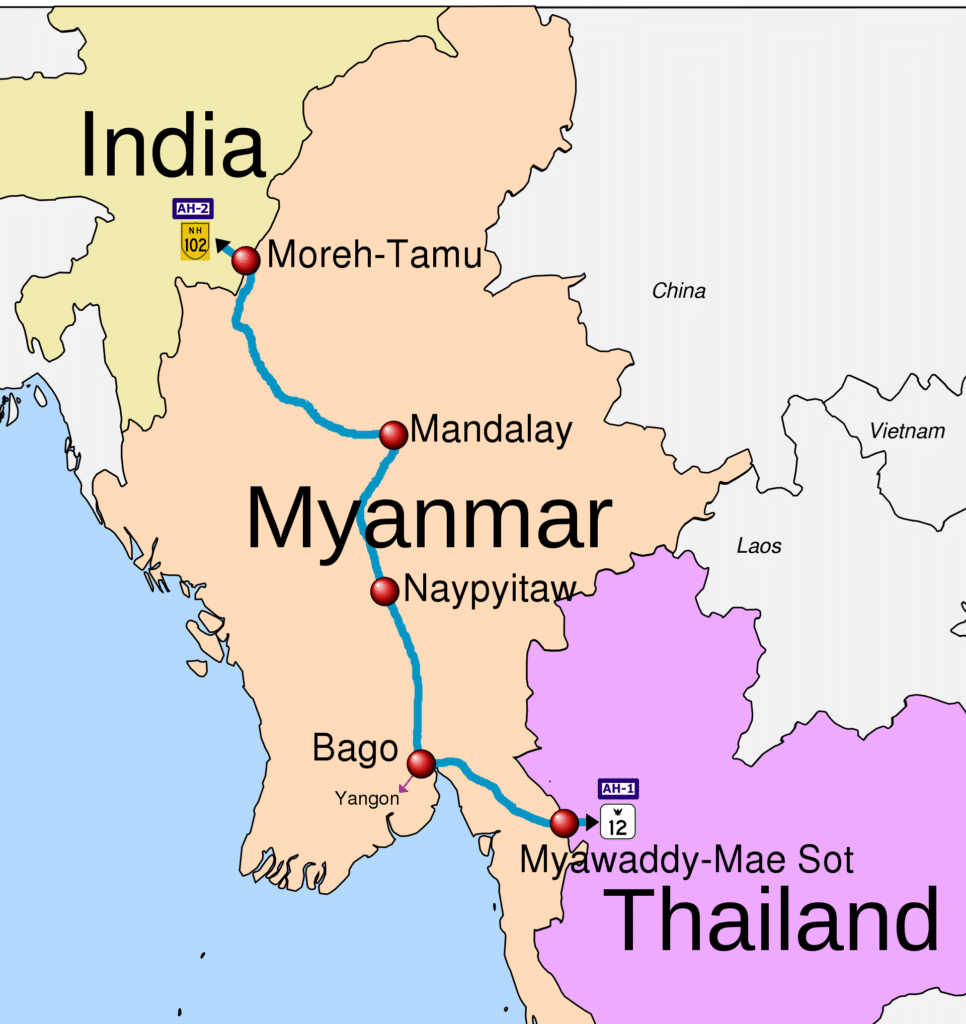
Defence cooperation
- The Indian and Myanmar armies have carried out two joint military operations, codenamed Operation Sun shine, to fight militants along the borders of Myanmar’s Rakhine state.
- India provides military training and conducts joint military exercises with the Myanmar Army like the India-Myanmar Bilateral Military Exercise (IMBAX-2017and IMBEX 2018-19), by which India had trained the Myanmar Army to be able to participate in UN Peacekeeping Operations.
- India and Myanmar signed a landmark defense cooperation agreement.
- The navies of both India and Myanmar conducted a historic bilateral naval exercise, IMNEX-18.
- India also invited the Myanmar Army to participate in the India-led multilateral Milan naval exercisethat occurs biennially in the Andaman and Nicobar Islands.
- To elevate its “Made in India” arms industry, India has identified Myanmar as key to increasing its military exports. Myanmar bought India’s first locally-produced anti-submarine torpedo, called TAL Shyena, acquired a diesel-electric Kilo-class submarine, INS Sindhuvir.
Security
- Indian and Myanmar troops carried out jointly Operation Sunrise and Operation Sunrise 2 in 2019 in their respective territories to destroy several insurgent camps.
- However the threat to the Kaladan multi-modal transit transport project, India’s gateway to Southeast Asia continues.
- India has also supported Myanmar in its efforts to combat Rohingya insurgent groups like the Arakan Rohingya Salvation Army (ARSA) and Aqa Mul Mujahideen (AMM), after Indian intelligence agencies found the ARSA and AMM to have links with terror groups like the Lashkar-e-Taiba (LeT) and Jaish-e-Mohammed (JeM) as well as reported Rohingya terrorists fighting alongside Pakistani extremists in Kashmir.
Diaspora and Culture
- Approximately 1.5 to 2.5 million people of Indian origin are living and working in various parts of Myanmar. The origin of the Indian community in Myanmar is traced to the mid-19th century with the advent of the British rule in Lower Burma in 1852. The two cities Yangon and Mandalay had a dominating presence of Indians in civil services, education, trade and commerce during the British rule.
- India and Myanmar share close cultural ties and a sense of deep kinship given India’s Buddhist heritage. An MoU has been signed on restoration of pagodas at Bagan underlining these ties.
- Also, the Agreement on Land Border Crossing (signed in May 2018) is a landmark in bilateral relations between the two countries as it will enable people from both countries to cross the land border with passport and visa, including for accessing health and education services, pilgrimage and tourism. Recently, two land-border crossings in Manipur and Mizoram have been opened.
Regional Cooperation
Association of South-East Asian Nation (ASEAN)
- Myanmar became a member of ASEAN in July 1997. As the only ASEAN country which shares a land border with India, Myanmar is a bridge between India and ASEAN.
- A few proposals for cooperation have been implemented and some are under discussions with Myanmar within the framework of ASEAN’s IAI programme.
Bay of Bengal Initiative for Multi-Sectoral
- Bay of Bengal Initiative for Multi-Sectoral Technical and Economic Cooperation (BIMSTEC), Myanmar became a member of BIMSTEC in December 1997. Myanmar is a signatory to the BIMSTEC Free Trade Agreement. Myanmar is the lead country for the energy sector.
- Myanmar trades mostly with Thailand and India in the BIMSTEC region. Myanmar’s major exports to India are agricultural products like beans, pulses and maize and forest products such as teak and hardwoods. Its imports from India include chemical products, pharmaceuticals, electrical appliances and transport equipment.
- The 13th BIMSTEC Ministerial Meeting was held in Myanmar in January 2011.
Mekong Ganga Cooperation
- Myanmar is a member of the Mekong Ganga Cooperation (MGC) since its inception in November 2000.
- MGC is an initiative by six countries – India and five ASEAN countries namely, Cambodia, Laos, Myanmar, Thailand and Vietnam – for cooperation in the fields of tourism, education, culture, transport and communication.
- The chairmanship of MGC is assumed by member countries in alphabetical order.
South Asian Association of Regional Cooperation (SAARC)
- Myanmar was given the status of observer in SAARC in August 2008. Myanmar request for full membership of SAARC has India’s support as it holds a lot of promise for their engagement which at a strategic and economic level, would prove to be mutually beneficial.
Disaster relief
- India responded promptly and effectively in rendering assistance after natural disaster in Myanmar such as the earthquake in Shan state (2010) Cyclone Mora (2017), and Komen (2015).
- India offered to help in capacity building in disaster risk mitigation as well as strengthening Myanmar’s National Disaster Response Mechanism.
- India granted 1.7 million Covid-19 vaccines to Myanmar in the months of January and February of 2021.
Capacity Building
- Capacity building has been accorded priority, with several new institutions set up for agricultural education, information technology and industrial training that have benefited Myanmar youth immensely.
- Myanmar Institute of Information Technology set up in Mandalay with the collaboration of IIIT Bangalore has been a success with all its graduates finding ready employment.
- The Advanced Centre for Agriculture Research and Education set up in collaboration with India’s ICAR is a fine example of pooling research efforts on pulses and oilseeds.
- India has also proposed to build a petroleum refinery in Myanmar. This is an indication of Myanmar’s growing significance in India.
- With the expansion of training facilities and supply of defence equipment needed by the Myanmar military, India has consistently strengthened defence ties.
- India’s timely help of medicines and equipment to fight the corona pandemic.
- A number of Indian companies have also set up operations in Myanmar, including oil and gas players like the ONGC Videsh and GAIL.
- India has also agreed to train Myanmar army officers and allow them to study at military academies in India.
Significance of Myanmar for India
- As India unveiled its Look East policy in the early 1990s, Myanmar became quite central to Delhi’s engagement with South East Asia.
- Myanmar is the natural land bridge between India and South-East Asia. Given the vast and shared maritime frontier in the Bay of Bengal and southern Myanmar’s location at the nexus between the Indian and Pacific Oceans, the eastern neighbour has also become an important element of India’s new maritime calculus.
- As SAARC situation is in doldrums, India is looking towards a platform like BIMSTEC and Myanmar can play a salient role in this new strategic setting.
- The security of North-Eastern States of India requires Myanmar cooperation in checking insurgency and trafficking. Myanmar, though not a part of the South China Sea dispute, is both directly and indirectly affected. The direct impact is geographic as it shares borders with China. As regards the US-China rivalry and rising Chinese assertiveness in the region, cooperation with Myanmar is of strategic importance to India.
- As part of India’s SAGAR Vision, India developed the Sittwe port in Myanmar’s Rakhine state.
- The port is meant to be India’s answer to the Chinese-fronted Kyaukpyu port, which is intended to cement China’s geostrategic footprint in Rakhine.
- It is therefore in India’s interest to see Myanmar prevail as a stable and autonomous country, thereby making possible greater bilateral engagement in India-Myanmar relations.
India’s primary interests in Myanmar
- To build an economic and security relationship that prevent Myanmar from slipping into the orbit of China.
- Ensure the Myanmar military’s cooperation in preventing Northeastern militants, most notably Naga insurgents, from using Myanmar as a safe haven.
- Support the country’s transition into a full-fledged federal democracy.
- Ameliorate the plight of the Rohingyas as well as ensure the tense relations between Bangladesh and Myanmar do not spiral out of control.
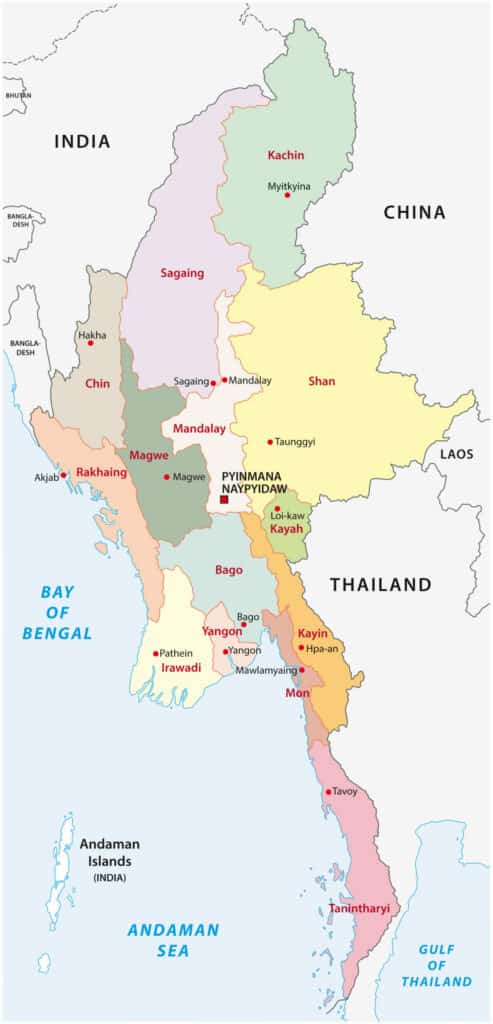
Challenges in Relations
Insurgency in North East India:
- Due to insurgency, India faces security and strategic challenges along porous Indo-Myanmar border. Cross-border crime, including goods, arms and counterfeit Indian currency, smuggling, drug trafficking are challenges along the Indo-Myanmar border. Given this context, India’s insurgency problems in the Northeast cannot be effectively tackled without Myanmar support.
Economic:
- India-Myanmar trade has remained below mutual expectations. This was due to Myanmar setting artificially high official exchange rates for its currency. Further, there was near absence of financial infrastructure such as banks and associated financial regulations.
- India sees Myanmar as being vital to fulfilling its ambition to become a $5 trillion economy by 2024. But with a total bilateral trade of $2 billion, India’s economic engagement with Myanmar lags behind China.
Connectivity:
- The absence of land and maritime connectivity networks between India and Myanmar has contributed to the low levels of trade with India.
Relations with China:
- The growing dependence of Myanmar on China is reflected from the elevation of bilateral relation to “a comprehensive strategic cooperative partnership,” Mynamar and China has agreed to enhance cooperation in border management and secure greater coordination in dealing with the U.N. and ASEAN.
- President of Myanmar called the equation with China “the closest and most important diplomatic relationship.” Increased dependence of China is detrimental to India’s interest and stability of the region.
Trans-Border Militancy:
- The ambush by NSCN (K) on June 4, 2015 on the convoy of an Indian Army in Chandel district in Manipur killing 18 soldiers and injuring 15, and the counter strike by the Indian Army on June 9 on two separate groups of insurgents along the India-Myanmar border have given a new dimension to the trans-border militancy with Myanmar. Later, surgical strikes by the Indian Army on the insurgent groups inflicted huge damage to ultras.
Rohingya Crisis:
- There are 16,500 Rohingya spread across several cities in India. The long burning issue of the Rohingyas in Myanmar has recently become a point of debate in India, with the Indian government insisting on their deportation based on perceived threats to India’s national security that connect radical Rohingya groups to Jihadist organisations. India’s claim to send the Rohingyas back to Myanmar rests on the notion that the refugees are of Burmese origin. However, the Burmese do not consider the Rohingyas as their citizens and consider them to be immigrants who were brought in from Bangladesh during the British colonial rule. The passing around of the responsibility of the Rohingyas from one state to another has resulted in this group of around one million floating in mid-air to be coined ‘stateless’ by the United Nations.
- Initially, India has been perceived as reticent to take any firm stance on the Rohingya issue, and that reticence was substantially impacting India’s image as a regional leader. China was much more proactive and played a mediatory role in the issue. Later, India categorically conveyed that it wants the “safe, secure sustainable” return of the Rohingya refugees. To facilitate the sustainable return of the Rohingya, India had signed an agreement with Myanmar in December 2017, with construction of prefabricated housing in Rakhine state for the displaced persons as a key initiative.
Way Forward
- Acknowledging the Military’s Primacy: The role of Myanmar’s army would be key to the unfolding of any democratic transition there, so India’s active engagement would be needed with the military.
- Even as India continues to call for a restoration of the democratic process, it shall engage with the army in Myanmar to address Indian concerns as well. Marginalising the army will only push it into China’s arms.
- Cultural Diplomacy: India’s cultural diplomacy through the lens of Buddhism can be leveraged for strengthening its ties with Myanmar.
- India’s “Buddhist Circuit” initiative, which seeks to double foreign tourist arrivals by connecting ancient Buddhist heritage sites across different states in India, should resonate with Buddhist-majority Myanmar.
- This could also build up India’s diplomatic reservoir of goodwill and trust with Buddhist-majority countries such as Myanmar.
- Resolving Rohingyas Issue: The quicker the Rohingya issue is resolved, the easier it will be for India to manage its relations with Myanmar and Bangladesh, focusing instead more on bilateral and subregional economic cooperation.
- India as the largest and a vibrant democracy can share its experience and best practices with Myanmar to make its democratic evolution robust and responsive in coming years.
- Building institutions, human resource development and capacity building are other areas in which both sides can collaborate for mutual benefits. India’s policy towards its religious and ethnic minorities can serve as a glowing example for Myanmar in framing its own policies.
Conclusion
- It is imperative that, like the other immediate neighbours of Myanmar, India too reaches out and shapes its own trajectory in Myanmar.
- The complexity of India’s regional security and neighbourhood demands India to adopt a more nuanced position without losing its essential pragmatism in engaging with Myanmar.
- Over the last two decades, India’s relationship with Myanmar has steadily expanded. The focus was on restoring high level political exchanges, renewing economic ties, and reviving trans-border links between India’s North East and northern Myanmar.
- Moving forward, a proactive India would prevent ceding space to other countries in taking lead on major issues in Myanmar. India, which has high stakes in global and regional governance, must ensure its voice is heard on key issues such as the Rohingya crisis.
